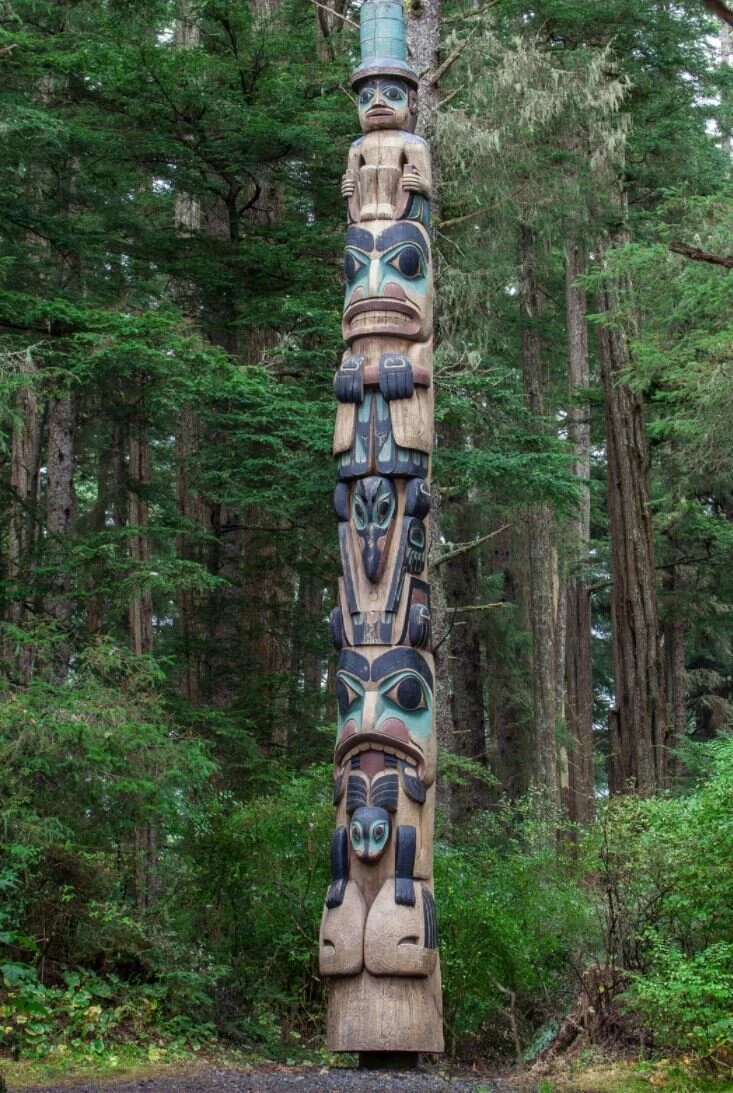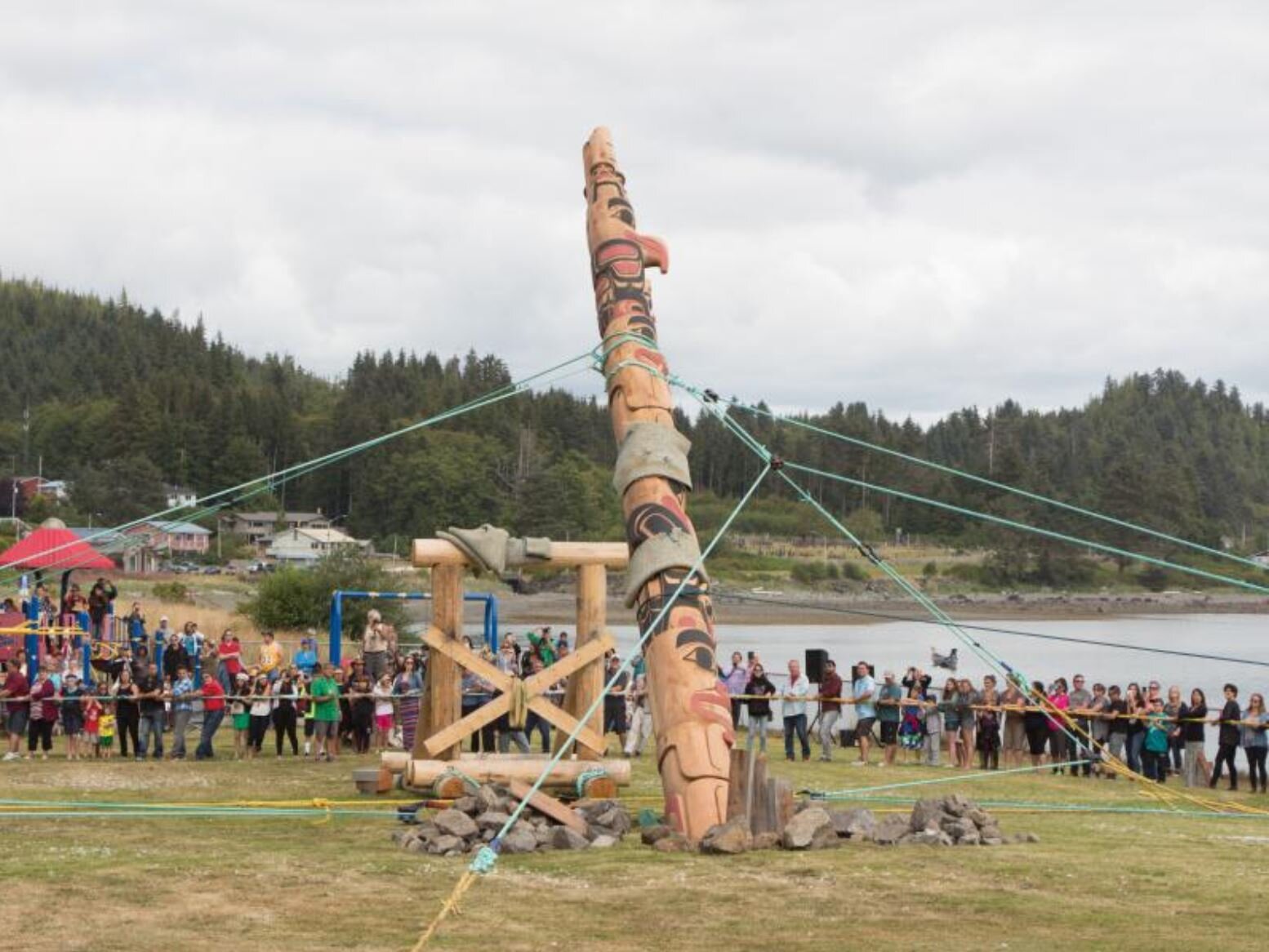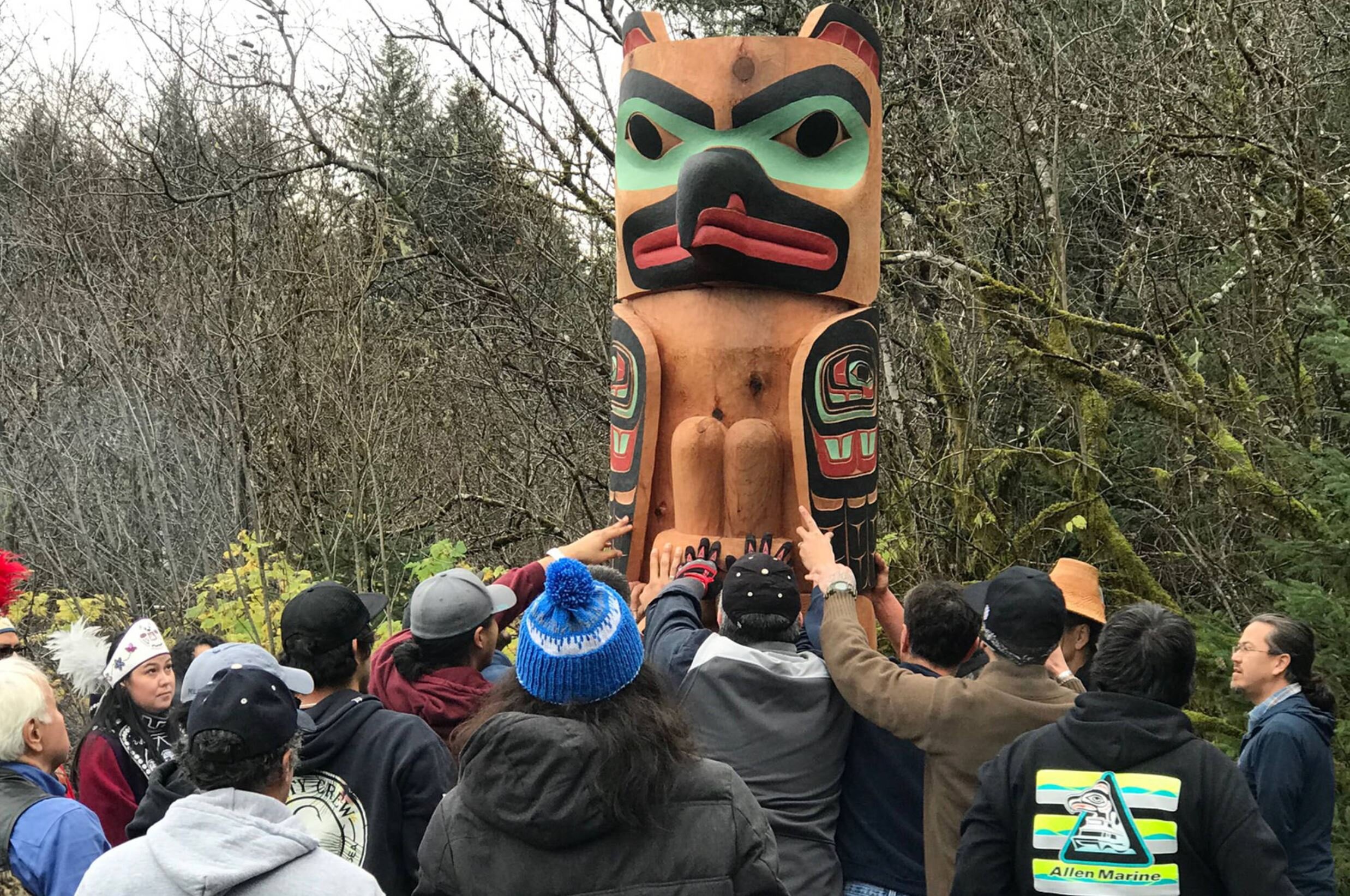By Hannah Pembroke
Alaskan Native communities heavily rely on animals for sustenance and inspiration, especially in regards to the bases of their social structure. The tradition of stories being passed through families and communities spans generations, leading to much of the various clans’ unique identities. Each animal holds its own story and spiritual meaning. These meanings have translated into the identities for several Alaskan Native clans in the Southeast region. The spiritual representation of an animal is often embodied and eternalized through a totem pole. The word “totem” is actually a misnomer that stems from totemism, which “was thought to be the primordial religion” of the communities which create totem poles. 1 While this name provides an appealing mystery to the carvings, it is entirely inaccurate. These totem poles are symbols of a community's history, values, and traditions, but not the base of a religion. Each aspect of a totem pole is as important and individualized as the animal it is based on. The four clans that have a particularly rich history involving the totem pole are the Eyak, Tlingit, Haida and Tsimshian cultures. These communities are marked on the map below by a totem pole.
Photo courtesy of Alaska Native Heritage Center
The use of animals in totem poles is not only traditional, but it is also highly important. The animals chosen to be in a specific totem pole carry great significance and demonstrate each culture’s interpretation of the spiritual meaning of the wildlife around them. The way a pole is constructed also holds importance. Different clans and regions will carve different types of poles depending on their inter-clan traditions. For example, “[t]he Coast Salish of the Lower Fraser [tend] to carve house posts rather than single stand-alone poles,” where most clans carve single poles that suit an occasion or family.2 Most commonly, totem poles range from 9 to 59 feet tall, though height varies greatly depending on clan and culture. The Haida and Tsimshian generally carve taller poles, “often reaching over 100 feet.” 2 Every aspect of a totem pole holds cultural significance, even the wood it is carved from. Due to the coastal environment in which the Eyak, Tlingit, Haida and Tsimshian have made their homes, totem poles are usually “made from a large red cedar tree. Some totem poles were also made from yellow cedar.” 2
A totem-pole raising ceremony. Photo courtesy of Paula Worthington/Zen Seekers
The importance of the totem pole is marked before the carving even begins. After a careful selection process for discerning which tree is most suited for the particular totem pole, “many coastal First Nations [and Tribal] communities will perform a ceremony of gratitude and respect in honor of the tree. Several trees may be inspected before a particular tree is chosen for its beauty and character.” 2 The selection of trees is an honored and careful process, as it requires “an intimate understanding of cultural histories and forest ecology.” 2 One area of trees cannot be overharvested, and balance must be maintained throughout the community and local vegetation.
The carving process is also unique among tribes. Carving has traditionally only been done by men. However, women have occasionally done carvings as well. A totem carver begins honing their craft at a very young age, and it is seen as an honorable and important role in the community. 2 Each tribe has a specific style and process, with some carving “around the pole[,] and others would carve out the back of the pole.” 3
The Sealaska Heritage Institute hired two brothers to carve an Eagle and Raven totem pole to replace the older ones at Gajaa Hít. The two new totem poles will represent the first people of Juneau, the Auk Kwáan, which includes the Wooshkeetaan (Shark) and L’eeneidí (Dog Salmon) clans. 8
Photo courtesy of White Wolf Pack
The general structure of a totem pole includes a main moiety, a clan animal, and passive and aggressive animals that are on the clan crest. They can communicate a narrative, but mostly they mark “a family’s lineage and validating the powerful rights and privileges that the family held.” 2 A moiety is defined in an anthropological lens by the Oxford Dictionary as, “each of two social or ritual groups into which a people is divided.” Each Alaskan moiety is represented by an animal, and the clans (and families within those clans) are represented as supporting animals to the main moiety. The two main moieties in which a people is divided into are based on lineage; however, they are then divided into smaller clans based on location and more immediate family groupings. These divisions are based on maternal lineage, and “all people in a clan can trace their relatives to the same ancestor.” 3
A pole-raising ceremony in celebration of the first Tlingit totem pole carved by a female artist. The work was completed in honor of the artist’s grandfather. The artist, Alison Marks, carved a raven on the top (as seen in the picture) which was her grandfather’s clan, and beneath is a carving of her father holding his signature coffee thermos.
Photo courtesy of Thom Landgreen/Juneau Empire
The Tlingits of Southeast Alaska are separated into the Raven Moiety and the Eagle Moiety (which was once the Wolf Moiety). The Haida moieties are represented by the same animals as the Tlingit moieties, but because they are a different people, they must be seen as an entirely separate unit. Within both the Tlingit and Haida Tribes, The Raven is a symbol of “creation, transformation, knowledge[, and] prestige as well as the complexity of nature and the subtlety of truth.” 4 The Eagle is seen as having the closest relationship with The Creator out of all the animals, and it represents “focus, strength, peace, leadership, and ultimate prestige.” 5 However, the Eagle can also be a symbol of the balance and coexistence of men and women, with its two wings representing the two genders in harmony.5
The clan animals associated with the Tlingit’s Raven moiety are Frog, Beaver, and Salmon, while the Haida Raven’s crest animals are Wolf, Killer Whale, and Bear. The clan animals associated with the Tlingit’s Eagle moiety are Wolf, Killer Whale, and Bear, and under the Haida’s Eagle moiety are Frog, Beaver, and Hummingbird.3 The Tsimshian people are separated into four moieties: Raven, Wolf, Eagle, and Killer whale. Raven and Eagle maintain similar meanings as those of the Tlingit and Haida moieties. Wolf is renowned for its incredible supernatural powers and hunting abilities, and it represents “loyalty, strong family ties, good communication, education, understanding, and intelligence.” 6 Killer whale, or Orca, is a protector of travelers and “symbolizes family, romance, longevity, harmony, travel, community and protection.” 7 Most Tsimshian people demonstrate their moiety through wearing a gwish’na’ba’la, or “button blanket,” that depicts their crest.3
Cedar Tlingit totem pole in Sitka, AK. Photo courtesy of shakzu/Getty Images/Canva
Each clan has its own crest which incorporates their clan animal as well as their moiety. Balance, above all else, is the focus when carving totem poles and pairing animals together. This sense of balance is maintained through the binding of “passive and aggressive animals.” 3 Passive and aggressive animals can be fairly intuitively identified by whether or not they are predators in the wild. For example, Wolf is an aggressive animal, while Beaver is a passive animal, meaning that the two could potentially be compatible to pair together. The combination of moiety, clan animal, and a maintained equilibrium between passive and aggressive animals is usually how a totem pole is designed. However, the design differs depending on what, or who, it must represent.
This mural is on the side of a building in the Wooshkitaan Eagle Clan. The main image is a Thunderbird, capturing an orca, surrounded by sharks. The Thunderbird is marked with its totem animal on its chest, and the Orca has its own totem poles on either side. The Thunderbird, Orca, Shark, and Wolf are all animals representative of the Wooshkitaan Eagle Clan. Painting this mural on the side of a building signifies the power and protection the community has, and it depicts the clan’s communal history and lineage.
Photo courtesy of Atlantic Art Partners/Unframed
Opposing clans balance sports, debates, and land, and most aspects of life are divided by moiety and clan. The Tlingits maintain a delicate balance between Raven and Eagle members, and in order to not disrupt any part of their life, they organize their social structure very specifically. This historically extends to if a Raven member is killed by an Eagle member, a similarly ranked member of the Eagle moiety must also be killed.3 However, the moieties are also harmoniously bound to one another. If one clan loses a member of its community, the other clans will provide comfort and aid.
The animals used in totem poles are incredibly significant in Alaskan Native culture, especially in regards to maintaining cultural and environmental balance. While not an act of religious discipline, the time and energy put into the carving of these huge structures demonstrates the significance specific animals have represented for Alaskan Native communities. The variation and specification in meaning and origin story for the wildlife in each clan acts as a reminder that animals have changed human interactions since the beginning of community development in Alaska. Without the constant presence and the involvement that animals have with humans, totem poles would be empty creations. With the ever-growing need for balance between humans and animal kingdoms, totem poles act as a constant reminder that humanity would be insignificant without their relationship to animals.
Works Cited from:
1 Ramsay, Heather. “Totem Poles: Myth and Fact.” The Tyee, The Tyee, 31 Mar. 2011, thetyee.ca/Books/2011/03/31/TotemPoles/.
2 “Totem Poles.” Indigenousfoundations, indigenousfoundations.arts.ubc.ca/totem_poles/.
3 ”Clans and Moieties.” Unit 7. Sealaska Heritage. https://www.sealaskaheritage.org/sites/default/files/Unit%207_2.pdf
4 “The Raven Symbol.” Spirits of the West Coast Art Gallery Inc, spiritsofthewestcoast.com/collections/the-raven-symbol.
5 “The Eagle Symbol.” Spirits of the West Coast Art Gallery Inc, spiritsofthewestcoast.com/collections/the-eagle-symbol.
6 “The Wolf Symbol.” Spirits of the West Coast Art Gallery Inc, spiritsofthewestcoast.com/collections/the-wolf-symbol.
7 “The Orca Symbol.” Spirits of the West Coast Art Gallery Inc, spiritsofthewestcoast.com/collections/the-orca-symbol-or-killer-whale.
8 White Wolf. “Amazing Step-by-Step Carving of Eagle Totem Pole by Young Brothers (Photos).” White Wolf, www.whitewolfpack.com/2013/08/amazing-step-by-step-carving-of-eagle.html.








